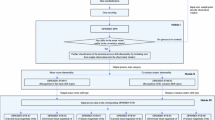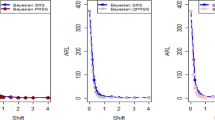Abstract
Nowadays, modern computers in general and the PC in particular have made the continuous high-speed acquisition and inspection accessible and during the last decade, multivariate control charts were given more attention and became so popular in real-world manufacturing scenarios. However, most conventional multivariate control charts share the same problem: they can only detect an out-of-control circumstance but cannot directly point out which variable or group of variables has caused the out-of-control signal. This study proposes an effective MSPC model enabled by two-level discrete particle swarm optimization-based selective ensemble of learning vector quantization networks (DPSOSENLVQ) for monitoring and diagnosing of mean shifts in multivariate manufacturing processes. In this model, one DPSOSENLVQ is developed for detecting out-of-control signals in process mean, while the other DPSOSENLVQ is developed for further classifying the detected out-of-control signals as one of the specific mean shift types. The experimental result indicates that the proposed MSPC model can not only efficiently monitor the process state but also accurately diagnose the detected out-of-control signals. Empirical comparisons also showed that the proposed MSPC model outperformed other existing approaches in literature. In addition, a case study is conducted to demonstrate how the proposed MSPC model can function as an effective tool for monitoring and diagnosing of mean shifts in multivariate manufacturing processes.

Similar content being viewed by others
References
Aparisi, F., Avendano, G., & Sanz, J. (2006). Techniques to interpret \(\text{ T }^{2}\) control chart signals. IIE Transactions, 38(8), 647–657.
Barghash, M. A., & Santarisi, N. S. (2004). Pattern recognition of control charts using artificial neural networks—Analyzing the effect of the training parameters. Journal of Intelligent Manufacturing, 15, 635–644.
Breiman, L. (1996). Bagging predictors. Machine Learning, 24(2), 123–140.
Chen, L. H., & Wang, T. Y. (2004). Artificial neural networks to classify mean shifts from multivariate \(\text{ T }^{2}\) chart signals. Computers and Industrial Engineering, 47(2–3), 195–205.
Crosier, R. B. (1988). Multivariate generalizations of cumulative sum quality control schemes. Technometrics, 30(3), 291–303.
Desieno, D. (1988). Adding a conscience to competitive learning. In Proceedings of international joint conference on neural networks (pp. 117–124). San Diego, CA: IEEE Press.
El-Midany, T. T., El-Baz, M. A., & Abd-Elwahed, M. S. (2010). A proposed framework for control chart pattern recognition in multivariate process using artificial neural networks. Expert Systems with Applications, 37(2), 1035–1042.
Gu, N., Cao, Z. Q., & Xie, L. J., et al. (2012). Identification of concurrent control chart patterns with singular spectrum analysis and learning vector quantization. Journal of Intelligent Manufacturing. doi:10.1007/s10845-012-0659-0.
Guh, R. S., & Tannock, J. D. T. (1999). A neural network approach to characterize pattern parameters in process control charts. Journal of Intelligent Manufacturing, 10(5), 449–462.
Guh, R. S. (2007). On-line identification and quantification of mean shifts in bivariate processes using a neural network-based approach. Quality and Reliability Engineering International, 23(3), 367–385.
Guh, R. S., & Shiue, Y. R. (2008). An effective application of decision tree learning for online detection of mean shifts in multivariate control charts. Computers and Industrial Engineering, 55(2), 475–493.
Hansen, L. K., & Salamon, P. (1990). Neural network ensembles. IEEE Transactions on Pattern Analysis and Machine Intelligence, 12(10), 993–1001.
He, S.-G., He, Z., & Wang G. A. (2013). Online monitoring and fault identification of mean shifts in bivariate processes using decision tree learning techniques. Journal of Intelligent Manufacturing, 24, 25–34.
Hotelling, H. H. (1947). Multivariate quality control. In C. Eisenhart, M. W. Hastay, W. A. Wallis (Eds.) Techniques of statistical analysis. New York: McGraw-Hill.
Hwarng, H. B., & Hubele, N. F. (1993). X-bar control chart pattern identification through efficient off-line neural network training. IIE Transactions, 25(3), 27–40.
Hwarng, H. B., & Hubele, N. F. (1993). Back-propagation pattern recognizers for X-bar control charts: Methodology and performance. Computers and Industrial Engineering, 24(2), 219–235.
Jackson, J. E. (1985). Multivariate quality control. Communications in Statistics-Theory and Methods, 14(110), 2657–2688.
Jiang, P. Y., Liu, D. Y., & Zeng, Z. J. (2009). Recognizing control chart patterns with neural network and numerical fitting. Journal of Intelligent Manufacturing, 20, 625–635.
Kennedy, J., & Eberhart, R. (1997). A discrete binary version of the particle swarm optimization. In Proceedings of the IEEE international conference on computational cybernetics and simulation (pp. 4104–4108). Piscataway, NJ: IEEE Press.
Kohonen, T., Barna, G., & Chrisley, R. (1988). Statistical pattern recognition with neural networks: Benchmarking studies. In Proceedings of international joint conference on neural networks (pp. 161–168). San Diego, CA: IEEE Press.
Kohonen, T. (1995). Self organization maps. Heidelberg: Springer.
Krogh, A., & Vedelsby, J. (1995). Neural network ensembles cross validation, and active learning. In Advances in neural information processing systems 7 (pp. 231–238). Denver, CO, Cambridge, MA: MIT Press.
Law, A. M., & Kelton, W. D. (1982). Simulation modeling and analysis. New York: McGraw-Hill.
Lehman, R. S. (1977). Computer simulation and modeling: An introduction. London: Lawrence Erlbaum.
Li, X. L., & Yao, X. (2005). Multi-scale statistical process monitoring in machining. IEEE Transactions on Industrial Electronics, 52(3), 922–924.
Low, C., Hsu, C. M., & Yu, F. J. (2003). Analysis of variations in a multi-variate process using neural networks. International Journal of Advanced Manufacturing Technology, 22(11–12), 911–921.
Lowry, C. A., Woodall, W. H., Champ, C. W., & Rigdon, S. E. (1992). A multivariate exponentially weighted moving average control chart. Technometrics, 34(1), 46–53.
Niaki, S. T. A., & Abbasi, B. (2005). Fault diagnosis in multivariate control charts using artificial neural networks. International Quality and Reliability Engineering, 21(8), 825–840.
Pignatiello, J. J., & Runger, G. C. (1990). Comparisons of multivariate CUSUM charts. Journal of Quality Technology, 22(3), 173–186.
Ryan, T. P. (1989). Statistical methods for quality improvement. New York: Wiley.
Salehi, M., Bahreininejad, A., & Nakhai, I. (2011). On-line analysis of out-of-control signals in multivariate manufacturing processes using a hybrid learning-based model. Neurocomputing, 74(12–13), 2083–2095.
The MathWorks Company. (2004). Neural network toolbox. The Math Works Inc.
Wang, T. Y., & Chen, L. H. (2002). Mean shifts detection and classification in multivariate process: A neural-fuzzy approach. Journal of Intelligent Manufacturing, 13(3), 211–221.
Wang, C.-H., & Kuo, W. (2007). Identification of control chart patterns using wavelet filtering and robust fuzzy clustering. Journal of Intelligent Manufacturing, 18, 343–350.
Wang, C.-H., Dong, T.-P., & Kuo, W. (2009). A hybrid approach for identification of concurrent control chart patterns. Journal of Intelligent Manufacturing, 20, 409–419.
Yu, J. B., & Xi, L. F. (2009). A neural network ensemble-based model for on-line monitoring and diagnosis of out of control signals in multivariate manufacturing processes. Expert Systems with Applications, 36(1), 909–921.
Zhou, Z. H., Wu, J. X., & Tang, W. (2002). Ensembling neural networks: many could be better than all. Artificial Intelligence, 137(1–2), 239–263.
Acknowledgments
This work was supported by the Program for Changjiang Scholars and Innovative Research Team in University under Grant IRT0968. The authors would like to express sincere appreciation to the the anonymous referees for their detailed and helpful comments to improve the quality of this article.
Author information
Authors and Affiliations
Corresponding author
Rights and permissions
About this article
Cite this article
Yang, WA. Monitoring and diagnosing of mean shifts in multivariate manufacturing processes using two-level selective ensemble of learning vector quantization neural networks. J Intell Manuf 26, 769–783 (2015). https://doi.org/10.1007/s10845-013-0833-z
Received:
Accepted:
Published:
Issue Date:
DOI: https://doi.org/10.1007/s10845-013-0833-z




